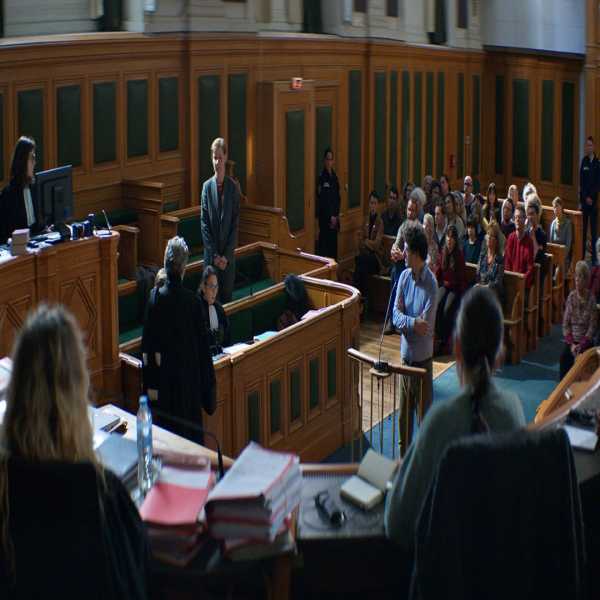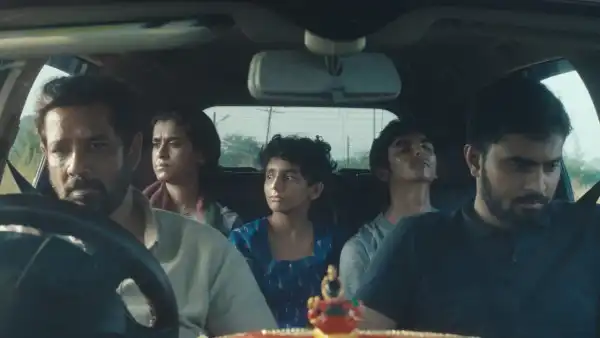
Save this storySave this storySave this storySave this story
The more I consider “Anatomy of a Fall,” the new French courtroom drama by Justine Triet that opens Friday, the more I love “France.” Not France the country (though it is something of a home away from home) but “France” the movie, Bruno Dumont’s frenetic 2021 satire about a TV journalist whose ambitious and intrepid reports, with their standardized format and their unchallenged attitudes, have become sensations of the mediascape. “Anatomy of a Fall” is something of a counterpart to those reports but in the cinematic realm; it’s both a product and an echo of high-minded consensus. It’s a movie of manifest ambition, suggested by the literary milieu in which it’s set and the themes that come with it, but one that realizes it’s ambition with prefabricated attitudes and a numbingly conventional form that only reinforces them. It’s prestige cinema.
The German actress Sandra Hüller stars as Sandra Voyter, a German writer whose husband, Samuel Maleski (Samuel Theis), falls to his death from the third-floor balcony of their isolated chalet. Sandra is accused of killing him, and her effort to clear her name at trial is complicated by the fact that the main witness to the couple’s life is their eleven-year-old son, Daniel (Milo Machado Graner), who is blind. On the day of Samuel’s death, Sandra is interviewed at home by a graduate student named Zoé (Camille Rutherford)—and, during the interview, Samuel blasts hip-hop (an instrumental version of 50 Cent’s “P.I.M.P.”) from his work room, upstairs, at ear-splitting volume, forcing the women to put an end to their talk. A short time later, Daniel returns from a walk with his dog, Snoop, and finds Samuel’s body in the snow. The prosecution begins to build its case around inconsistencies in Sandra’s account of the day, peculiarities in the forensic report on Samuel’s fatal injuries, and apparent discord in the couple’s relationship.
As the cinematic equivalent of an airport read, “Anatomy of a Fall” is adequate—not brisk but twisty, not stylish but unobtrusively informational. But the artistic failings are obvious and distracting throughout. For starters, it’s filled with herrings that surely turned red from blushing with shame, starting with the interview itself. To Zoé, Sandra talks in literary terms of the uncertain distinction of reality from fiction—an abstract theory that seems to provide ready-made self-exoneration in advance of any inconvenient evidence. There’s also Daniel’s visual impairment, which, though treated sensitively, hand-waves a facile metaphor regarding the source of knowledge and the nature of bearing witness. There’s Samuel’s obstreperous misbehavior, a seemingly obvious provocation of Sandra’s (murderous?) rage; the movie could be subtitled “Death of an Asshole.” There’s the fact of Samuel’s frustrated literary ambitions. There’s the revelation that Sandra is bisexual, which, as I watched the movie, struck me as an instant exoneration, for the simple reason that a film governed by high-minded consensus would no longer dare to posit a bisexual woman as a wanton killer; the same goes for the fact that Sandra is the more productive and successful writer, and that she’s a foreigner. There’s the prosecuting attorney’s buzzcut, suggesting that he’s a right-wing bigot who takes all these clues and identifiers as suspicious. He’s a perfect embodiment of traditionalist persecution of a sexually and intellectually free woman artist (and of a foreigner). Then, there’s the revelation that Samuel had been refusing to have sex with Sandra, which, I figured, made her an instant martyred innocent and put the movie a wink away from Samuel’s posthumous prosecution for abuse.
In short, “Anatomy of a Fall” is a movie of prefabricated attitudes, and its dramatic construction is airtight and incurious to match. The script (which Triet wrote with Arthur Harari) drops its tidbits of information into the action but offers no perspective on how its events unfold. There’s similarly no outside perspective on the court case, once that gets under way. No one says anything to anyone about it: not Sandra and her lawyers, Vincent Renzi (Swann Arlaud) and Nour Boudaoud (Saadia Bentaïeb), the former of whom is also her longtime friend; not journalists covering the trial; not Daniel’s godmother (Sophie Fillières). The direction of the courtroom scenes has the blandly declarative generality of a TV movie cramming its script details in ahead of the next commercial. Triet displays no sense of time, no sense of development, no sense of context, no sense of detail: Sandra’s hiring of Vincent, poof; for how much? (Fees are never mentioned, and neither is Sandra’s financial burden.) And Maître Boudaoud? She just shows up. What about the selection of the jury? Not a hint.
The courtroom drama isn’t a major French genre, but, as it happens, it provided the basis for one of the best of all recent French movies, “Saint Omer,” directed by Alice Diop, which was released in 2022. Unlike “Anatomy of a Fall,” Diop’s film has its perspective built into it; the trial is observed by a writer whose discussions about it and attitudes toward it play a major role. The social context is central to the movie—both the writer and the accused are Black women of African descent, and this matters in the trial, figures in the events under scrutiny, and is central to the writer’s involvement. Diop, unlike Triet, shows a fascination with the rituals of the courtroom and the formalizing of discourse that results, and she invents a passionately original way of filming scenes on the witness stand. Her method seems to give a physical identity to the language of testimony and the thought behind it. The point isn’t that Triet or any other filmmaker should imitate Diop but that, even for a genre as familiar as the courtroom drama, there are cinematic discoveries waiting to be made.
On the other hand, Triet offers a wider range of forensic activity relating to Sandra’s case, and it gives rise to what is by far the best scene in the film, involving a physical reënactment of Samuel’s fall, done at the family chalet, by means of a dummy. It’s a stunning moment: the rapidity of the fall, the violence of the impact. Yet, here, too, a great cinematic opportunity is missed: the moment merely drops in and drops out, with no attention to the scientific planning or the specialized construction that would be required to make such an experiment happen. Thus, the strong effect of the fictionalized violence to a dummy is quickly dissipated in an insipid narrative broth. It’s a very strange moment that’s isolated for effect, but the main effect is to betray the film’s lack of interest in observation and in the physicality of the process at hand. Repudiating any hint of documentary-like curiosity—and also avoiding any distinctive artifice to get beyond dramatic information—Triet relies instead on a blandly academic realism that seals off any implications, social or psychological or practical, that aren’t hammered into the script emphatically and unambiguously. (Triet’s remarkable 2013 feature, “La Bataille de Solférino,” a.k.a. “Age of Panic,” is a deft and fascinating blend of fiction and documentary, imagination and observation; it’s dismaying to see her wander far from her own strengths and inspirations.)
It’s impossible to separate the minor virtues and major failings of “Anatomy of a Fall” from the prominence that it has so rapidly achieved. Selected to be screened in competition at this year’s Cannes Film Festival, it won the Palme d’Or, the festival’s highest award. This week, it was shown at the New York Film Festival just ahead of its commercial release. I imagine the rising teen-age cinephile, just beginning to take an interest in world cinema and confidently seeking out such a film, bearing as it does the imprimatur of the art-house cinema’s high and venerable authorities as well as wide critical acclaim. I imagine the bewilderment that would follow the viewing—imagine it developing into a skepticism, or even wrath, that would risk engulfing far better films, ones also endorsed at the same festivals and hailed by the same notables. If this is the art of the movies, I imagine hearing, then movie art is bullshit. In the art-house consensus, the danger facing contemporary cinema is its artistic diminution brought about by the market dominance of commercially ravenous franchise films. The showcasing and enshrining of mediocre movies as masterworks poses as great a danger. ♦
Sourse: newyorker.com






